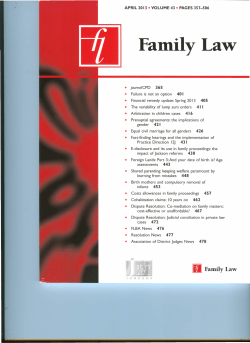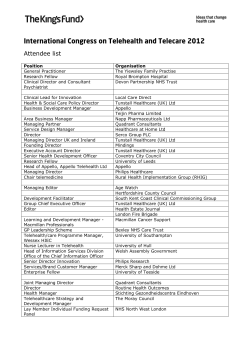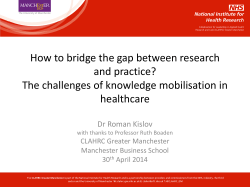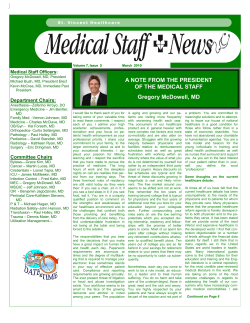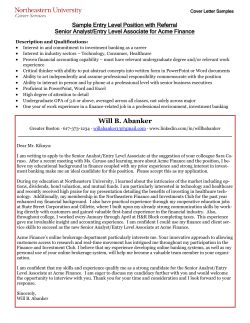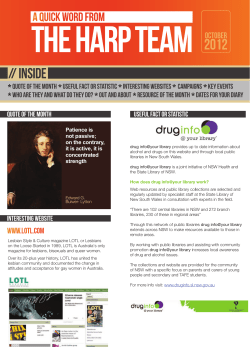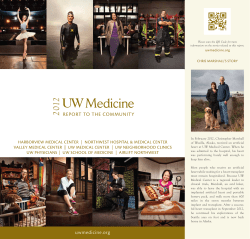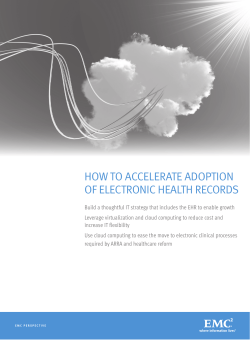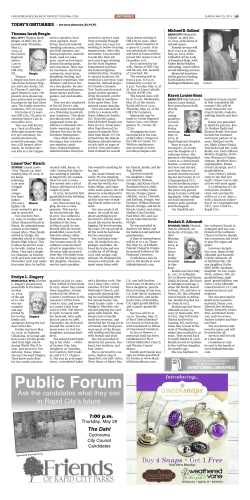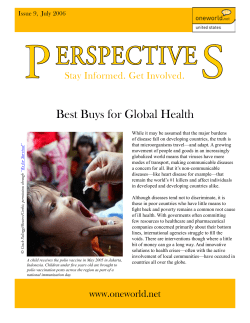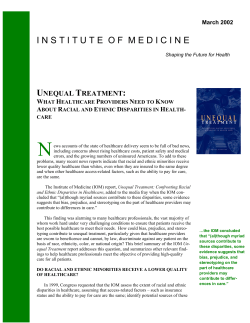
Global health infrastructure- challenges for the next decade
Global health infrastructurechallenges for the next decade Report of the HaCIRIC International Conference 2011 26 - 28 September, Manchester, UK Introduction Across the world, around $360 billion is expected to be spent annually over the next decade. HaCIRIC’s 2011 International Conference brought researchers and practitioners from across disciplines and countries to focus on key challenges in the provision of healthcare infrastructure for the 21st century. In this report, we present some of the insights from the conference. Slides for each of these presentations can be accessed at www.haciric.org in the section devoted to this conference. Keynote Speakers: Making hospitals elder-friendly and flexible is crucial to long-term sustainability Rudi van den Broek, (Chief Project Officer, Vancouver Island Health Authority) presented on his new hospital that was opened in Spring 2011 on Vancouver Island. It is designed to fit the expected ageing population and to be adaptable to changing needs over the next 50 years. In a presentation entitled ‘Hospital of the future - the 7 habits to an elder friendly hospital’, he argued that the goal was to design a 50-100 year asset that would be flexible for adaption many times in its life time. A key immediate requirement was that it should deal with ‘the tsunami of over 65 year olds’, a group that is rising dramatically in number and who are typically the most expensive patients to treat. Mr van den Broek said that hospitals of the future are for those patients with the highest cognitive and physical needs. He set out the ambition of the Vancouver hospital: ‘If we could build a hospital for these people then it will serve everyone. We wanted there to be uncluttered calm, quite obvious ways to get around the hospital with hand rails, clear delineation of the wall and floors, easy access to outdoors including handrails. We also wanted to have kitchen facilities. We want an environment that is engaging and attractive to families. We want it to be harder not to wash hands than it is to wash them.’ He said the design of the hospital in Vancouver included 400 changes to the bedrooms, which were mocked up in the design process. ‘Mocking up five bedrooms and doing fullscale reviews of them cost us Canadian$150,000 but saved us millions,’ he said. The hospital was opened after a relatively short development process, lasting three years and eight months from start to finish. Among the innovations are hand rails from the beds straight to the bathroom, to prevent falls and reduce calls for staff assistance. All doors required patient validation via a reference group of over 65 year olds. Initial evaluation of the recently opened hospital is encouraging: inter-unit transfers have been reduced by 46 per cent; average length of stay has fallen from ten to eight days; hand washing is up 9 points at 74 per cent and overhead pages to staff are down 98 per cent from 12,300 to just over 200, reflecting reduced stress on patients and staff. The hospital is open to visitors all the time - visiting hours have been abandoned. There is anecdotal evidence of 1 improved sleeping , reduced aggression, better communications, improved biking by staff to work and satisfaction at enhanced access to nature. Mr van den Broek highlighted seven principles for effective change in such developments. 1. Begin with the End: Envision the ideal characteristics 2. Be Proactive: Your decisions are the primary determining factor for effectiveness 3. First Things First: Plan, prioritize, and execute on importance rather than urgency 4. Have Fun: Balance and renew your resources to create a sustainable project 5. Synergize: Combine the strengths of people through positive teamwork. 6. Seek First to Understand: Empathetically listen and keep an open mind. 7. Think Win-Win: Strive for mutually beneficial solutions See the presentation slides: http://www.haciric.org/static/doc/events/Hospital_of_the_Future_-_Rudi.pdf Infrastructure as a means of redesigning unscheduled care services Dr Mike Burrows (Chief Executive of NHS Manchester) presented on the process of renewing acute and primary healthcare in a deprived part of Greater Manchester. He set out a series of lessons learned. Dr Burrows described how Salford PCT, of which he was then Chief Executive, covered an area of Greater Manchester that has considerable social deprivation and improving but higher than average mortality and morbidity for a wide range of conditions, including all the main cancers. These challenges were compounded by outdated healthcare infrastructure, notably Salford Royal Hospital, which was built in the Victorian era, with Nightingale wards. An asset was that the PCT was co-terminus with local government and Salford Royal was the sole, local acute hospital and long-overdue for renewal. His presentation dealt with the renewal of the acute facility. First, he sketched the activities required to develop a cross-institutional body entitled ‘Salford Health Investment for Tomorrow’. SHIFT’s role was to establish a vision for health renewal and a process whereby needs and service redesign led infrastructural renewal. The work faced issues such as emergency bed usage running at 60 per cent above the national norm. Against this backdrop and high levels of acute illness, Dr Burrows’ team had an ambitious goal to shift from a 400 to a 340 medical beds hospital. Some of the solutions adopted included opening a range of intermediate care beds that could also operate as ‘step-up’ beds to reduce acute admissions. Salford PCT also opened Walk-In Centres, which, though popular, failed to impact on A+ E attendance and so were eventually closed. A new Manchester Triage System was designed which included primary care and not just those seeking treatment from emergency departments. Placing GPs into A+ E departments proved unsuccessful in reducing admissions as they soon tended to adopt the same risk approach as hospital doctors. A big step forward has been to develop a rudimentary Integrated Record System of primary and acute care, which has improved both the speed and quality of hospital diagnoses. Some good outcomes of the service redesign and the new infrastructure have included reducing attendance at A+E and some acute admissions. Bed days have been reduced in emergency care. See presentation slides including the lessons learned at Salford PCT: http://www.haciric.org/static/doc/events/HACIRIC.pdf 2 Driving adoption of technology in the NHS Sally Chisholm (CEO, NHS Technology Adoption Centre) explained how widespread research shows that the NHS is very slow at taking innovative technologies and using them in routine clinical practice. She added that it was clear that adoptions have to be driven systematically in a very structured way but the multiplicity of stakeholders in the NHS makes this very difficult to achieve. She added: ‘This is the time to innovate – industries that continue to trade in the long term are the ones that innovate in the down time.’ The presentation set out five steps to improve the adoption of innovation in the NHS. They are: 1. Understand the nature of the problem that requires solution. 2. Identify with stakeholders the key measures of what would be success in solving the problem(s). 3. Collect evidence in the NHS of real clinical outcomes from the change and clear information about how, for example, to procure the changes. 4. Identify the barriers to adoption and explain how they can be overcome. 5. Raise awareness to facilitate widespread adoption. See presentation slides: http://www.haciric.org/static/doc/events/HaCRIC_Conference_250911_v21.pdf General Presentations Focus on key stakeholders when transforming healthcare models Dr Danielle Tucker (Imperial College London) presented research looking at the management of rapid and fundamental change in care models. She detailed case studies currently underway of three hospitals in the US, Canada and the UK. Each is undergoing change in their care processes alongside a move to a new-build facility (a redesign around single bed rooms). Such radical organisational change requires careful planning and management and the involvement of stakeholders, within a time critical period. The team has found mixed levels of change management and engagement across the three sites. Contrary to current thinking, engagement was often most successful when focused on communicating with those who had most to gain from the transition, rather than being inclusive across the whole organisation. Initial indications suggest that successful transition management does need to include all stakeholders, that the impact of resistant or dysfunctional groups can be mitigated with strong buy-in from both top management and frontline staff. Read more: Conference Proceedings: page 83 See presentation slides: http://www.haciric.org/static/doc/events/HaCIRIC_conference_Tucker_Hendy_Barlow.pdf Consensual structures can help adoption of innovation, but may be used for delay Kyriakos Hatzaras (Imperial College London) explored the efficacy of consensual politics in advancing healthcare reform through supporting innovation adoption. The case examined is the Slovene national eHealth project, funded by the government of Slovenia and the EU, which aims to deliver a new national eHealth network, eHealth portal and national Electronic Health Record (EHR), education and training for health professionals. This case study suggests that healthcare is a policy area where reform is influenced by the domestic political culture and mode of policy-making chosen to bring about reform. It further shows that consensual structures introduced to facilitate policy design contribute positively to 3 the adoption of innovation at the start of healthcare reform. However, stakeholders may also take advantage of opportunities offered by consensual policy-making structures and use their leverage to delay or stall reform. Read more: Conference Proceedings: page 84 See presentation slides: http://www.haciric.org/static/doc/events/HaCIRIC11_eHealth_Slovenia_K_S_HATZARAS.pdf Integrate evidence-based implementation into routine clinical practice In the current political and economic climate the drive to improve quality in healthcare must be met by the delivery of evidence-based practices that benefit patients at a population level. To maximise outputs from the production and synthesis of knowledge that underpins Evidence-Based Medicine, the research agenda must support Evidence-Based Implementation. Dr Julie Reed (NIHR CLAHRC for Northwest London, Imperial College London, Chelsea and Westminster Hospital NHS Foundation Trust) explored the concept of Evidence-Based Implementation (EBI) using five case studies from the NIHR CLAHRC for Northwest London. The findings suggest that EBI is feasible, but that further work is required to operationalise current knowledge through optimisation of tools, methods, education and support infrastructures to facilitate a systematic approach to EBI. Dr Reed argued that any approach to Evidence-Based Implementation needs to be integrated into routine clinical practice if Evidence-Based Medicine is to be widely implemented and sustained. Researchers must engage directly with frontline staff to develop fit-for-purpose approaches to deliver improvements in patient care and outcomes. Read more: Conference Proceedings: page 100 See presentation slides: http://www.haciric.org/static/doc/events/20110927_HaCIRIC_v1.0_Julie_.pdf Trans-cranial ultrasound devices could hold key to transformation of acute stroke care Dr Henry Feldman (Harvard Medical School) and Dr Evin Jacobson (Imperial College Business School) presented on progress in the field of stroke care. Dr Jacobson presented on latest analysis of stroke treatment for patients in Scotland (see details on presentation slides below) Dr Feldman detailed how the number of patients presenting with symptoms of stroke early enough to qualify for potentially reversing thrombolytic therapy is constrained partly by the availability of imaging technology to determine that the stroke is ischaemic, rather than haemorrhagic. He said that field-based ultrasound devices on ambulances, particularly in geographical locations distant from stroke treatment centres, represent a disruptive innovation: making use of smaller, cheaper ultrasound devices, which are ‘good enough’ to determine the type of stroke. He argued that off-the-shelf, trans-cranial ultrasound devices might offer a convenient and reliable means to rule out the diagnosis of haemorrhage and improve the effectiveness of the early management of stroke. This technology could potentially facilitate faster diagnosis, earlier therapeutic administration of thrombolytic agents, and lead to improved mortality and reduced morbidity. He also suggested a discrete-event simulation study, focusing on alternative patient pathways. This allows evaluations of the potential health systems effect of field-based diagnostic devices and of teleradiology. 4 Read more: Conference Proceedings: page 122 See presentation slides for Dr Jacobson: http://www.haciric.org/static/doc/events/2.1Evin-Haciric_stroke_.pdf Cost-benefit strengths in Electronic Health Record systems Georgios Xydopoulos (Brunel University) detailed how in recent years Electronic Health Record (EHR) systems have been introduced in the healthcare practice of many countries and numerous studies have been carried out to analyse them. He presented evidence that the incorporation of more information in the EHR and the access to this information databases by various organizations can have a catalysing effect and lead to revolutionary changes in healthcare systems. He explored the broader value and implications from the use of the information that EHR systems provide, arguing that Cost Benefit Analysis applied to the context of EHR show a promising future from EHR usage by healthcare organizations. Read more: Conference Proceedings: page 136 See presentation slides: http://www.haciric.org/static/doc/events/georgios.pdf Engagement is crucial to success of niche-innovation processes Hendrik Cramer (University of Twente) detailed a study that deals with a niche-innovation process which aims to develop a business strategy for an integrated area and healthcare delivery project in the Netherlands. The goal is to explore the critical events and barriers on the strategic level during the niche-innovation process in order to improve business strategy formation in integrated area and healthcare delivery projects. It is a longitudinal study in which the first two authors are engaged as action researchers in order to get an authentic understanding of the niche-innovation processes. The analysis shows that it is all about engaging actors, sharing and exchanging visions and expectations in order to reduce uncertainty and create commitment. Read more: Conference Proceedings: page 147 See presentation slides: http://www.haciric.org/static/doc/events/Business_Strategy_Formation__(Cramer_Dewulf_Voordijk)_-_HaCIRIC_Conference_27_09_2011_Final_1.1_.pdf Factors identified that support long-term flexibility in healthcare facilities Assistant Professor Jane Carthey (University of New South Wales) detailed research on approaches to achieving flexible and adaptable health facilities. It has focussed on five case studies in Australia, visiting and documenting key adaptability features of each case study facility and consulting with health facility personnel where available. Findings suggest that longer-term flexibility is assisted by: generous site area, lower rise hospital buildings along a horizontal circulation spine (‘hospital street‘), surplus building services capacity facilitating easy expansion/alteration, and a consistent workable planning grid supporting a range of standardised room sizes. Read more: Conference Proceedings: 160 See presentation slides: http://www.haciric.org/static/doc/events/Carthey_HaCIRIC092011.pdf Study shows how design management reduces over-runs and improves quality Sergio Kemmer (University of Salford) set out research into resolving complex problems of design management that can lead to cost and schedule overruns, accidents, lower than expected quality and inadequate functionality. Investigation, drawing on data from six healthcare construction projects reveals that new approaches have been developed to tackle 5 such problems. The research aims to show how successful projects are dealing with integration between design, production, and operations, through an appropriate approach to the management of production systems. It aims to assist the different parties of the AEC industry to better understand how practices applied into design phase could support efficiency in the management of production systems. Read more: Conference Proceedings: page 176 See presentation slides: http://www.haciric.org/static/doc/events/Sergio_2011_09_27_Presentation_HaCIRIC_Confer ence_Lean_design.pdf Better knowledge management needed to consolidate healthcare building standards Dr Michael Phiri (University of Sheffield) detailed research into the contemporary relevance of healthcare building standards/norms and tools especially in underpinning quality and safety in environments where care is provided. Findings indicate the need for continued rationalisation of published material to create core standards that facilitate frequent updates and reduce development costs, to offer opportunities for design quality improvements, creativity and innovation. It is also essential to strengthen and build on key guiding principles for the development of a best-practice framework that addresses the challenges of quality, innovation, productivity and prevention to guide healthcare decision-makers. Read more: Conference Proceedings: page 190 See presentation slides: http://www.haciric.org/static/doc/events/Michael_HaCIRIC_Con_Sept2011V3.pdf Involving healthcare professionals is key to accurate product costs for healthcare Dr Anja Kern (Imperial College London) detailed research into the challenge of producing accurate product costs for healthcare. There are problems not only of errors but also the organizational challenge of involving non-accountants in cost system design. Her research, based on a field study undertaken in a UK Health Trust, examines both of these issues. Read more: Conference Proceedings: page 212 See presentation slides: http://www.haciric.org/static/doc/events/haciric_conference_2011_27092011_ak.pdf Web-tool simplifies complex issues around health financing choices in poorer countries Dr Christina Pagel (University College London) detailed work on developing a web-based tool to help low and middle income countries to develop robust health financing policies to increase service coverage. The tool helps them make best use of complex existing research evidence around health financing mechanisms that may be difficult for policy makers to access. The tool shows the impact of different health financing mechanisms on potential policy goals such as promoting equity and reducing poverty. The web-based tool provides graphical summaries that allow a user to assess in a single graphic: the number of relevant studies, the heterogeneity of evidence, where key evidence is lacking and how closely the evidence matches their own context. Read more: Conference Proceedings: page 213 See presentation slides: http://www.haciric.org/static/doc/events/4.2Pagel_HaCiric_2011_1.pdf Benefits Quantification Method translates stakeholder views into common currency 6 Benefits Quantification Method is a practical approach to engaging stakeholders in the definition and judgement of benefits sought from investments in healthcare infrastructure; most notably buildings. Dr Derek Thomson (Loughborough University) set out the theory that underpins BQM and presented a hypothetical example of its use derived from insights gained during its development. As many of these benefits are intangible and cannot be directly measured, the extent of their realisation must be judged by the stakeholders to whom they will accrue. This requires a participatory approach to defining investment project intent and monitoring performance in realising those benefits. Dr Thomson explained the role of a BQM Facilitator in engaging stakeholders in the translation of programme-level, strategic benefits into the project-level, tactical benefits they seek. His presentation addressed the practicalities of translating abstract definitions of benefits into practical explanations of what stakeholders expect benefits realisation to ‘look like’ when achieved. It particularly identified the need for rigour in translating stakeholder observations of benefits into meaningful quantifications. Read more: Conference Proceedings: page 224 See presentation slides: http://www.haciric.org/static/doc/events/haciric_2011_presentation_v31.pdf Brighton ‘3Ts’hospital development builds new template for low carbon design Matthew Bacon of Eleven Informatics LLP presented on the continuing failure of the NHS Estate, in common with a large number of buildings, to deliver low carbon performance, thus potentially jeopardising the Governments targets for a low carbon economy. He noted that, in 2006, the National Audit office expressed concern that 80 per cent of government estate was failing to perform to the required standards and a 2009 follow up study showed little improvement. His presentation described a new approach to low carbon design being undertaken by the authors on the project known as ‘3T‘s’ for the Brighton and Sussex University Hospitals NHS Trust. The work is developing a fundamentally new approach to low carbon design for hospital facilities. Read more: Conference Proceedings: page 244 Simulation offers developing countries new way to fashion TB control programmes Ivor Langley (Liverpool School of Tropical Medicine) detailed how the introduction and scale-up of new tools for the diagnosis of Tuberculosis (TB) in developing countries has the potential to make a huge difference to the lives of millions of people living in poverty. To achieve this, he said, policy makers need the information to make the right decisions about which new tools to implement and where in the health infrastructure to apply them most effectively. These decisions are difficult as new and expensive tools are developed and the health system and patient impacts are uncertain, particularly in poor and rural settings. The presentation demonstrated how a discrete-event simulation, linked to transmission models, can play a significant part in improving and informing these decisions. Results were presented for a diagnostic facility in Tanzania which can be used to evaluate alternative tools to provide policy makers with valuable information on health systems costs and patient outcomes. Read more: Conference Proceedings: page 262 7 See presentation slides: http://www.haciric.org/static/doc/events/langley.pdf Resistance more than technology hampers adoption of Building Information Modelling Ergo Pikas (Technion - Israel Institute of Technology) set out the strategic reasons for deploying Building Information Modelling, based on evidence from 13 healthcare projects in the US and the UK. His presentation detailed initial findings indicating that use of BIM enables a holistic view of project delivery and helps to integrate project parties into a collaborative process. However, the initiative to implement BIM must come from the top down to enable early involvement of all key stakeholders. It seems that a key factor hindering the utilization of BIM is resistance from people to new ways of working and thinking more than immaturity of the technology required for the exercise. Read more: Conference Proceedings: page 286 Ends 8
© Copyright 2025



